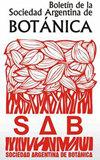阿根廷中西部土壤粗糙度微地形特征及生物结皮的影响
IF 0.7
4区 生物学
Q4 PLANT SCIENCES
Boletin De La Sociedad Argentina De Botanica
Pub Date : 2019-11-27
DOI:10.31055/1851.2372.v54.n4.24163
引用次数: 2
摘要
背景与目的:生物土壤结皮(BSC)对土壤粗糙度的影响是这些群落在生态系统水平上的重要功能。我们的目的是表征不同类型的BSC的微地形特征,并评估它们对土壤粗糙度的影响,沿着三个不同程度的干旱系统。MM采用不同又相辅相成的技术:链法、照相分析法和金属棒法。对于第一个系统,我们使用了块设计,而对于另外两个系统,我们研究了每个系统中主要生物结壳的类型。结果:BSC的形态随优势生物类型的不同而不同。其中,苔藓高度较低,为平缓起伏型;蓝藻较高,为陡峰型;地衣有两个高度频率,为起伏型。平衡计分卡对三个评价点的粗糙度有影响。占主导地位的平衡记分卡类型影响所发现的粗糙度水平。高度干旱样地是BSC对粗糙度影响最显著的样地。结论:BSC提供的微地形变化和粗糙度的增加是理解Monte动态的关键,因为土壤上的小中断,如BSC产生的土壤中断,可以增加水分有效性,减少侵蚀造成的养分损失,这是这些脆弱系统功能的两个基本方面。本文章由计算机程序翻译,如有差异,请以英文原文为准。
Caracterización microtopográfica e influencia de las costras biológicas en la rugosidad del suelo en el centro-oeste de la Argentina
Background and aims: The influence of biological soil crusts (BSC) on soil roughness is an important function of these communities at the ecosystem level. Our objective was to characterize microtopographically the different types of BSC and evaluate their effect on the roughness of the soil along three systems differentiated by their degree of aridity.
MM by different and complementary techniques: chain method, photographic analysis and technique of metal rods. For the first one, a block design was used, while for the other two, we worked on the types of dominant biological crusts in each system.
Results: The morphology of the BSC varied according to the type of dominant organism. The mosses had a low height and were classified as gently undulating, the cyanobacteria had more abrupt peaks, and was classified as pinnacled, and the lichens had two height frequencies and were classified as rolling. The BSC influenced the roughness in the three sites evaluated. The type of BSC that dominated influenced the level of roughness found. The hyper-arid site was the site where the BSC had the most significant impact on roughness.
Conclusions: The microtopographic variations and the increase in roughness provided by the BSC is key to understanding the dynamics of the Monte because small interruptions on the soil such as those generated by the BSC could increase water availability and decrease nutrient losses by erosion, two fundamental aspects of the functioning of these fragile systems.
求助全文
通过发布文献求助,成功后即可免费获取论文全文。
去求助
来源期刊

Boletin De La Sociedad Argentina De Botanica
PLANT SCIENCES-
CiteScore
1.00
自引率
33.30%
发文量
46
审稿时长
>12 weeks
期刊介绍:
Bol. Soc. Argent. Bot. publishes original scientific works from the whole spectrum of Plant Biology (structure, anatomy, development, physiology, cytology, genetics, evolution, ecology, paleobotany, palynology, ethnobotany, etc.) in the diverse vegetable organisms and related groups (mycology, ficology, lichenology, briology, etc.), both in basic and applied aspects.
Taxonomic works (of systematics, phylogeny, monographs, revisions, lectotypifications, nomenclatural acts, descriptions of taxa), phytogeographic and phytosociological works (survey and classification of vegetation at different spatial scales and without restriction of methodological approaches) are considered for publication. Contributions that address complete phytogeographic units or sub-units and those that fill gaps in knowledge of vegetation in little-known territories are especially welcome. Extensions of geographical areas are published only when it comes to new citations for a country. Checklists and lists of annotated plants are not published.
Articles submitted for publication must be original and must not have been submitted to another publisher or previously published (print or electronic format). Submissions of papers already published in another language will not be accepted (autoplagio for translation).
 求助内容:
求助内容: 应助结果提醒方式:
应助结果提醒方式:


